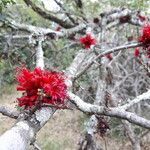A shrub or small, slender tree up to 7 m, sometimes semi-climbing, often forming tangled thickets. Bark: grey and smoothish, becoming dark brown and rough with age. Leaves: with 3-5 pairs of opposite leaflets; leaflets elliptic to almost round, 1.5-2.5 x 1-2 cm; apex broadly tapering and abruptly narrowly pointed to rounded and notched; base tapering to rounded, almost symmetric; margin entire; petiolules absent; petiole 1-6 mm long. Flowers: a dense, congested, almost spherical, branched head or panicle, 3-8 cm in diameter; on short spur-branchlets or, occasionally, terminal; the conspicuous stamens, joined at the base to form a distinct sheath, give the flowers a `bottle-brush' appearance; petals well developed and, like the sepals, blood red. Fruit: a flattened pod, up to 12 x 4 cm, with the characteristic persistent rim. Seeds: oval, 1.5-2 cm in diameter, pale brown, with a large yellow aril.
A shrub or slender tree. It grows up to 6 m tall. Mostly it has a single stem but may have several stems. The branches point upwards. The bark is grey. The leaves are divided once. The leaves are 8 cm long and they fold along the midrib. There are usually 3-5 pairs of leaflets. They are rounded and 1.3-2.5 cm long. They do not have a stalk but have a sharply pointed tip. The flowers are bight scarlet and cup shaped. They occur in dense round bunches at the ends of branches. They flowers have lots of nectar. This is edible. The pods are large and woody. The edges have a broad rim. There are several pale seeds with a yellow layer around them.
Leaves paripinnate; stipules up to 8 × 4.5 mm, broadly and asymmetrically triangular, acuminate at apex, rounded and sometimes tooothed at base, caducous; petiole 0.2–0.7 cm long, glabrous or sparsely puberulous; rachis 3.5–6.5 cm long, glabrous or sparsely puberulous, narrowly winged, the wing broadening distally between each pair of leaflets; leaflets opposite, (3)4–6-jugate, 2.7–4.5 × 1.2–3.2 cm, broadly elliptic to broadly obovate, almost symmetrical, glabrous, apex mucronate or apiculate, base cuneate, slightly asymmetrical; venation slightly prominent on both surfaces.
Many-stemmed shrub or slender tree, up to 7 m high. Leaflets 3-5(6) pairs per leaf. Flowers sessile, congested or on pedicels up to 1.5 mm long. Staminal tube forming a distinct sheath projecting as a narrow, irregular rim above junction of filaments. Petals 5, normally developed. Flowers scarlet.
Pod 7.5–10.5 × 2.5–4 cm, oblong, flattened, glabrous, brown, with a lignified upper suture which may persist, sometimes with the seeds and/or arils attached after the eventual dehiscence of the pod.
Inflorescence a dense subcapitate panicle; axis puberulous; bracts and bracteoles c.2 × 1 mm, broadly oblong-elliptic, early caducous, sparsely puberulous, margins shortly and sparsely ciliate.
Stamens 10, alternately long and short, basally connate into a distinct sheath; filaments c.20 mm long at anthesis, glabrous; anthers 2–2.5 mm long, elliptic, dorsifixed.
Ovary oblong, c.3 × 1.5 mm, glabrous; stipe short; style c.15 mm long, glabrous, stigma capitate, papillose.
Seeds c.10 × 10 × 5 mm, broadly ovoid, with a cup-shaped yellow aril extending about halfway up the seed.
Branchlets brown, soon becoming grey or dark brown, smooth, glabrous or sparsely puberulous, glabrescent.
Calyx lobes 4, broadly ovate, the outer two c.9 × 7 mm, the inner two narrower, glabrous.
Petals 5, bright red, c.15 × 4–5 mm, narrowly obovate, tapering gradually to the base.
Shrub or small tree, 1.5–7 m tall, sometimes scrambling or scandent.
Flowers bright red, almost sessile.
Hypanthium 3–4 mm long, glabrous.

